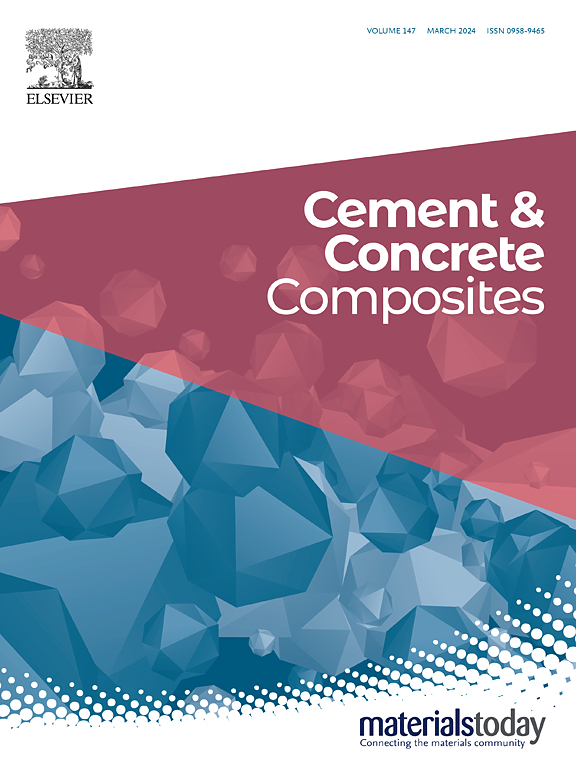光催化zno -地聚合物复合材料的评价:降解亚甲基蓝和α-蒎烯
IF 13.1
1区 工程技术
Q1 CONSTRUCTION & BUILDING TECHNOLOGY
引用次数: 0
摘要
以偏高岭土为原料合成了碱活化zno -地聚合物复合材料,研究了其在253.7 nm辐照下对亚甲基蓝和α-蒎烯的光催化降解效果。采用x射线衍射(XRD)、傅里叶变换红外光谱(FTIR)、核磁共振(NMR)、氮气吸附、扫描电镜(SEM)、透射电镜(TEM)和紫外可见光谱对Si/Al摩尔比(1和2)、ZnO/Al负载(0.10、0.15和0.20)制备的复合材料进行了表征。采用特制的流动池进行气相α-蒎烯降解,同时在批处理条件下评价水相亚甲基蓝的降解效果。研究的一个关键发现是ZnO含量的增加导致基体致密化,表面积减小,吸附带蓝移。结构研究表明,ZnO通过与复合材料中的铝结合而集成到地聚合物框架中。硅铝比为2的地聚合物对亚甲基蓝的去除率最高,达到160 mg/L(91.05%),这归功于偏高岭土中天然存在的TiO2相加上高表面积。这些样品表现出良好的α-蒎烯连续降解能力,最大去除率为26.93%,这是由于Al-OH表面基团的减少和较低的亲水性,有利于VOC的吸附。值得注意的是,本研究确定了将ZnO加入地聚合物框架的关键参数,表明ZnO的添加浓度和ZnO引起的微观结构修饰在决定光催化活性方面起着重要作用。本研究揭示了氧化锌对地聚合物理化特性的影响,以及对水、气环境中污染物的修复机制。本文章由计算机程序翻译,如有差异,请以英文原文为准。


Evaluation of photocatalytic ZnO-geopolymer composites: degradation of methylene blue and α-pinene
Alkali-activated ZnO–geopolymer composites were synthesised using metakaolin to investigate their photocatalytic degradation efficiency toward methylene blue and α-pinene under 253.7 nm irradiation. Composites prepared with bulk Si/Al molar ratios (1 and 2), ZnO/Al loadings (0.10, 0.15, and 0.20), were characterised using X-ray diffraction (XRD), Fourier transform infrared spectroscopy (FTIR), nuclear magnetic resonance (NMR), N2-sorption, scanning electron microscopy (SEM), transmission electron microscopy (TEM) and UV–vis spectroscopy. A custom-built flow cell was used for gas-phase α-pinene degradation, while aqueous methylene blue degradation was evaluated under batch conditions. A key finding of the study was that increasing ZnO content led to matrix densification, reduced surface area, and blue shifting of the adsorption band. Structural studies revealed that ZnO was integrated into the geopolymer framework through bonding with aluminium within the composite. The highest 160 mg/L methylene blue removal (91.05 %) was achieved by a geopolymer with Si/Al ratio of 2 and attributed to naturally occurring TiO2 phases in the metakaolin coupled with a high surface area. These samples exhibited superior continuous α-pinene degradation, with a maximum removal of 26.93 %, which was attributed to reduced Al–OH surface groups and lower hydrophilicity, favouring VOC adsorption. Significantly, this research identifies the critical parameters of incorporating ZnO into a geopolymer framework, suggesting that both the concentration of ZnO added, and the microstructural modification induced by ZnO play important roles in determining photocatalytic activity. This study revealed how ZnO influences the physicochemical characteristics of geopolymers, and the remediation mechanism of pollutants from aqueous and gaseous environments.
求助全文
通过发布文献求助,成功后即可免费获取论文全文。
去求助
来源期刊

Cement & concrete composites
工程技术-材料科学:复合
CiteScore
18.70
自引率
11.40%
发文量
459
审稿时长
65 days
期刊介绍:
Cement & concrete composites focuses on advancements in cement-concrete composite technology and the production, use, and performance of cement-based construction materials. It covers a wide range of materials, including fiber-reinforced composites, polymer composites, ferrocement, and those incorporating special aggregates or waste materials. Major themes include microstructure, material properties, testing, durability, mechanics, modeling, design, fabrication, and practical applications. The journal welcomes papers on structural behavior, field studies, repair and maintenance, serviceability, and sustainability. It aims to enhance understanding, provide a platform for unconventional materials, promote low-cost energy-saving materials, and bridge the gap between materials science, engineering, and construction. Special issues on emerging topics are also published to encourage collaboration between materials scientists, engineers, designers, and fabricators.
 求助内容:
求助内容: 应助结果提醒方式:
应助结果提醒方式:


